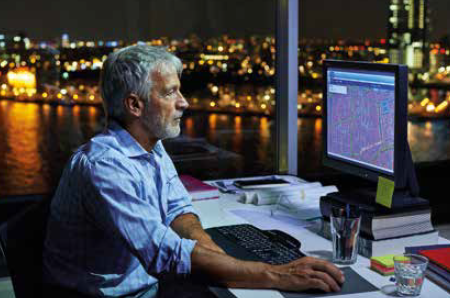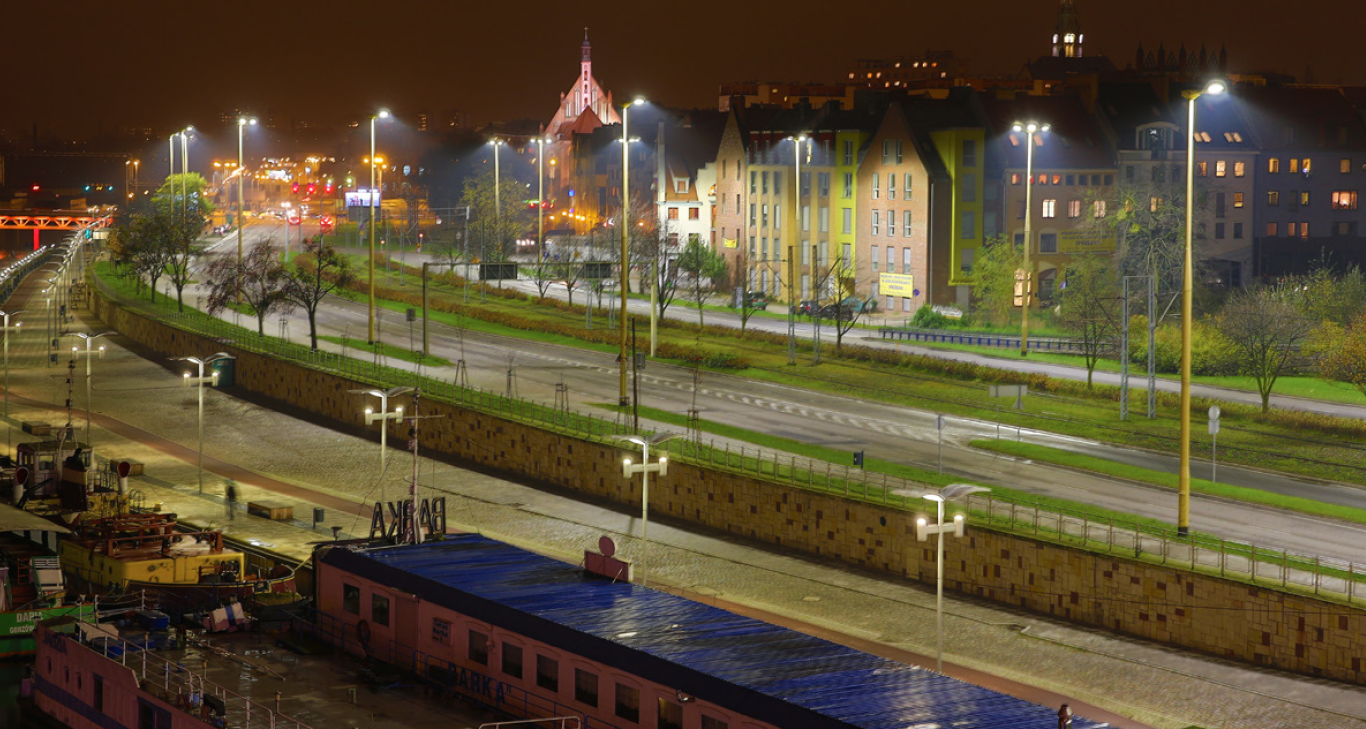With the advent of LEDs, streetlighting is not just about illumination anymore, as Mark Halper discovers.

Remember when streetlights were for illuminating roadways and walkways? How quaint. Those were the days when a light was a light, and an electronic chip was an electronic chip. But no more.
Lighting has gone digital with the advent of LEDs, and with that, streetlights are starting to double up not only as light sources, but also as information technology do-it-alls that will help cities monitor and control everything from traffic to air quality to crowds and noise. This data will help local authorities decide when to grit roads, locate parking spaces for stressedout motorists, reroute cars and trucks as necessary, and much, much more. The possibilities are as endless as the imagination. One city even wants to use them to monitor the bird population.
The idea is simple: embed sensors in the same luminaires or on the lighting columns that house them. Program those sensors to do whatever it is you want – detect traffic congestion or available parking spaces, for instance – and then send that information through digital networks to public and private parties who would benefit from it. All the while, the same networks would serve as the conduit for remotely controlling LED lights to turn on and off, to brighten, flash, dim or even change colours, allowing cities to make the most of the low-energy lighting benefits of its LED streetlights.
Early days
It’s an idea that’s in its early stages, but one that cities around the world are eyeing up. Metropolises from China to the West including Los Angeles, Buenos Aires, Milan, Copenhagen, Paris, San Diego and Bristol, England share a vision of using existing or new lighting infrastructure as the backbone of vital urban information networks.
‘Lights are these veins of connectivity flowing through the city, and every city has to have them,’ notes Paul Wilson, managing director for Bristol is Open, an ambitious, fledgling ‘internet of things’ programme intended to connect sensors on lighting columns and other objects into a network of data accessible to not only the city but also to businesses and schools.
That resonates with Jacob Lundgaard, director of living labs for Gate 21, a public-private partnership that is spearheading an intelligent streetlighting initiative in eight cities of the Danish-Swedish Oresund region including Copenhagen and Albertslund in Denmark, and Malmo and Lund in Sweden.
‘The lighting infrastructure really could be seen as a possible spine in the digital city, because the light poles are everywhere, they are connected with electricity, and it’s very easy to also put fibre in now when you’re putting up the poles,’ says Lundgaard. ‘So with the lighting infrastructure you have a physical structure in the city that you can connect a whole lot of smart city applications to.’
More than light
Sounds good. But while few people doubt the usefulness of intelligent lighting from a pure lighting perspective – using smart networks to control lights remotely, to watch for individual lamp outages, and even to measure the energy performance of individual lamps as Los Angeles has started to do with a web- based system from Philips – no-one has yet proven the value of gathering data from outside the lighting realm.
But that’s not stopping Bristol from kicking the tyres. It hopes to eventually connect some 35,000 lampposts into an open, smart wireless network provided by Silicon Valley firm Silver Spring Networks, and it has started by outfitting 1,500 lighting columns with sensors that will measure things like light, heat, vibration, air quality and other physical variables.
One specific application will be to measure the winter temperature of road surfaces, calling out gritting crews when the mercury drops to 3ºC at specific cold locations, but sparing the city the costs at locations that remain above that mandatory gritting level. Currently, trucks will blanket the entire city when the general forecast indicates chilliness.
‘There’s actually all sorts of people coming up with many ideas next, like smart parking,’ says Wilson. ‘Or even Shazaming the birds so you can know what the bird population is.’ (Shazam is the popular app that people use to identify songs they hear randomly.
Wilson says the same technology could help monitor which bird species are present and thus help inform bird protection and green space policy making. At the the moment, he emphasises,‘it’s just a concept’.)
Streaming data
Silver Spring, the same wireless networking company that is building the Bristol network, has also installed sensors on columns in Glasgow that are streaming information about air quality and noise from a bike path along the River Clyde and from outside Glasgow Central railway station. It’s all part of £24 million UK-government funded Future Cities Demonstrator initiative in that city.
But it is indeed early days in all these places, like in Denmark and Sweden.
‘The problem is that all these new technologies that you can attach to lighting technologies are quite new and there are a lot more questions than answers right now as to what you can actually do by putting sensors on light poles,’ says Lundgaard at Gate 21, which is applying for €7 million (£5 million) in European funding to help find the answers in its eight-city Oresund trial.
In turn, that poses funding and business challenges to the entire value chain.
‘Everybody is talking about smart lighting, smart cities, smartification, searching for business models and partners,’ says Joerg Kupferschlaeger, street and tunnel lighting technical marketing manager at lighting vendor Osram. ‘It will happen, but what exactly, nobody really knows. Will we really have every luminaire measuring noise levels? I don’t know.’
Parking priority
Kupferschlaeger sees parking as a possible winner because ‘there a lot of business cases’. In one scenario, for instance, local shops could collectively support an app that alerts motorists to available parking, and then offers discounts to come in.
He’s hardly alone in viewing parking as one of the potential winners. It’s one that Bristol will test.
And it’s one of the first functions that the Danish Outdoor Lighting Laboratory (Doll) is preparing to examine as it moves into what it calls the ‘smart urban services’ phase of the expansive testbed it opened in Albertslund last September, which has already attracted scrutiny and visits from scores of major cities around the world. Until now, its five miles of LED lighting has been used to study the future of lighting controls rather than non-lighting functions.
Soon, Doll will start experimenting with systems developed by Thorn Lighting and technology firms Sensity Systems and Cisco that test a number of different parking schemes, including flashing or changing colours to show available street parking spaces, says Doll consultant Teddy Sibben Larsen.
And when GE Lighting announced earlier this year that it was providing smart streetlighting to San Diego, California and Jacksonville, Florida, it singled out parking as one of the potential uses.
GE noted at the time that with networked LED streetlights using sensors and transceivers in its Intelligent Environment for Cities technology (previously called Intelligent Cities) ‘drivers can be directed to available spaces’. It also noted other potential uses including traffic control.
But for now, most urban smart streetlighting implementations are focused specifically on lighting control. Like the GE installation in Buenos Aires. Like Osram’s project to control 140,000 LED lamps – mostly from AEC Illuminazione in Milan. And like Philips’ CityTouch web system in Los Angeles, which ties into more than 100,000 LED lamps supplied by other vendors. (In one future application, Los Angeles is considering flashing streetlights to guide fire and police crews to scenes).
Philips is as immersed as any supplier in exploring the non-lighting applications, but the idea is currently ‘at the rising edge of the hype curve,’ according to Martin Oerder, Philips’ head of product management for lighting systems. ‘I’m convinced it will come, but it still will take time .The experiments that are ongoing are also necessary to find the value of these applications. We as an industry and the cities still have to find out what is realistic.’
Privacy concerns
One of the aspects that cities will have to work out is assuring privacy of data.
And underlying everything is the technological question of which networking technology to use. A number are under consideration, from wired to wireless including GSM mobile phone technology, Wi-Fi, Bluetooth and others. Bristol has chosen to use a type of ‘mesh’ wireless internet network from Silver Spring known as IPv6, which Wilson says will be the key to truly opening the network to wide input and access.
‘Before you get to what the light can do, you kind of need to re-engineer the way the network works,’ says Bristol’s Wilson. ‘The networks in the past were not really built to do this. They were built for phones, or they were built for maybe emails. They weren’t really built for this kind of, “let’s connect everything to everything, and the internet of things”.’
Once it’s all in place it provides ‘a bedrock of data’, on which to make more informed and democratic decisions about how to run a city, notes Bristol’s Wilson. ‘You change the nature of city governance from one of “have a go, guessing and politics” to a much more scientific approach to doing things, to more democratisation. That’s the adventure of doing all of this.’
It seems that streetlights are certainly not simply for illuminating roadways anymore. They are also for making brighter collective minds that will make cities much smarter places. Welcome, it seems, to the second Age of Enlightenment.


